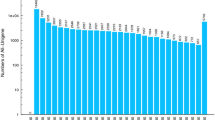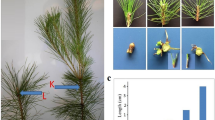Abstract
The branching angle is an important trait for controlling the crown architecture of trees. It is not only under genetic regulation, but is also affected by other factors such as environmental and hormones. It is of great significance to explore the molecular regulation mechanism of poplar branching angle; In this paper, transcriptome sequencing technology was used to generate cDNA libraries from axillary buds of the cultivar ‘Zhonglin 2025’ (a broad-crown poplar; BC) and Populus × zhaiguanheibaiyang (a narrow-crown poplar; NC). NC is characterized by a smaller branch angle than BC, a narrow crown shape, and rapid growth. At the same time, the transcriptome results were verified by qRT-PCR; The results showed that 193.4 million high-quality pure readings were obtained from the BC and NC cDNA libraries, and 1609 DEGs were detected, of which 822 were upregulated and 787 were downregulated. On the basis of functional annotation of the DEGs with gene ontology terms, 41 genes were associated with hormone synthesis and metabolism, 85 genes were associated with auxin transport, and 101 genes were involved in hormone signal transduction. The expression patterns of 12 DEGs associated with branch angle development were verified by qRTPCR, which revealed that the expression patterns were consistent with the results of transcriptome analysis. Quantification of phytohormone contents in axillary buds of NC and BC revealed that auxin content showed the greatest significant difference between NC and BC; Finally, we constructed a model for the phytohormone regulatory network associated with branching angle. It hopes to provide reference for the study of the molecular mechanism of poplar branching angle.







Similar content being viewed by others
Change history
13 November 2021
A Correction to this paper has been published: https://doi.org/10.1007/s11105-021-01322-6
References
Bao F, Shen J, Brady SR, Muday GK, Asami T, Yang Z (2004) Brassinosteroids interact with auxin to promote lateral root development in Arabidopsis. Plant Physiol 134:1624–1631
Blilou I et al (2005) The PIN auxin efflux facilitator network controls growth and patterning in Arabidopsis roots. Nat 433:39–44
Bouwmeester H, Fonne-Pfister R, Screpanti C, Mesmaeker AD (2019) Strigolactones. A new plant hormone with promising features Angewandte Chemie
Braun N et al. (2012) The pea TCP transcription factor PsBRC1 acts downstream of Strigolactones to control shoot branching. Plant Phys 158:225–238
Chen Y, Fan X, Song W, Zhang Y, Xu G (2012) Over-expression of OsPIN2 leads to increased tiller numbers, angle and shorter plant height through suppression of OsLAZY1. Plant Biotechnol J 10:139
Cheng Y (2006) Auxin biosynthesis by the YUCCA flavin monooxygenases controls the formation of floral organs and vascular tissues in Arabidopsis. Genes Dev 20:1790–1799
Cheng H et al. (2017) Integrative RNA- and miRNA-profile analysis reveals a likely role of BR and auxin signaling in branch angle regulation of B. napus. Int J Mol Sci 18:887
Cui D, Neill SJ, Tang Z, Cai W (2005) Gibberellin-regulated XET is differentially induced by auxin in rice leaf sheath bases during gravitropic bending. J Exp Bot 415
Dardick C et al (2013) PpeTAC11 promotes the horizontal growth of branches in peach trees and is a member of a functionally conserved gene family found in diverse plants species. Plant J Cell Mol Biol 75:618–630
Dai Y (2006) Increased Expression of MAP KINASE KINASE7 Causes Deficiency in Polar Auxin Transport and Leads to Plant Architectural Abnormality in Arabidopsis Plant Cell 18(2):308-320
Dai Y, Zhiming FU, Jianyang LI (2003) Isolation and Characterization of an Arabidopsis Bushy and Dwarf Mutant Acta Botanica Sinica 045(005):621-625
Dharmasiri S (2006) AXR4 is required for localization of the auxin influx facilitator AUX1. Sci 312:1218–1220
Duan J, Yu H, Yuan K, Liao Z, Meng X, Jing Y, Liu G, Chu J, Li J (2019) Strigolactone promotes cytokinin degradation through transcriptional activation of in rice. Proceedings of the National Academy of Sciences 116 (28):14319-14324
Dun EA, De SGA, Rameau C, Beveridge CA (2012) Antagonistic action of strigolactone and cytokinin in bud outgrowth control. Plant Physiol 158:487–498
Fang Z, Ji Y, Hu J, Guo R, Sun S, Wang X (2020) Strigolactones and Brassinosteroids Antagonistically Regulate the Stability of the D53–OsBZR1 Complex to Determine FC1 Expression in Rice Tillering. Molecular Plant 13 (4):586-597
Ferguson BJ, Beveridge CA (2009) Roles for auxin, cytokinin, and strigolactone in regulating shoot branching. Plant Physiol 149:1929–1944
Friml J, Rcaroní, Wi, Sacuteniewska J, Benková E, Mendgen K, Palme K (2002) Lateral relocation of auxin efflux regulator PIN3 mediates tropism in Arabidopsis. Nat 415:806
Fukazawa J, Ito T, Kamiya Y, Yamaguchi S, Takahashi Y (2015) Binding of GID1 to DELLAs promotes dissociation of GAF1 from DELLA in GA dependent manner. Plant Signal Behav 10
Fukazawa J et al (2014) DELLAs function as coactivators of GAI-ASSOCIATED FACTOR1 in regulation of gibberellin homeostasis and signaling in Arabidopsis. Plant Cell 26:2920–2938
Gallavotti A (2013) The role of auxin in shaping shoot architecture. J Exp Bot 64:2593–2608
Guo Y , Gan S. (2011) AtMYB2 regulates whole plant senescence by inhibiting cytokinin-mediated branching at late stages of development in Arabidopsis. Plant Physiol 156:1612–1619.
Harrison BR, Masson PH (2008) ARL2, ARG1 and PIN3 define a gravity signal transduction pathway in root statocytes. Plant Journal 53:380-392
Hu J, Ji Y, Hu X, Sun S, Wang X (2020) BES1 Functions as the Co-regulator of D53-like SMXLs to Inhibit BRC1 Expression in Strigolactone-Regulated Shoot Branching in Arabidopsis. Plant Communications 1 (3):100014
Jones B et al (2010) Cytokinin regulation of auxin synthesis in Arabidopsis involves a homeostatic feedback loop regulated via auxin and cytokinin signal transduction. Plant Cell 22:2956–2969
Kim H, Park PJ, Hwang HJ, Lee SY, Oh MH, Kim SG (2006) Brassinosteroid signals control expression of the AXR3/IAA17 gene in the cross-talk point with auxin in root development. J Agric Chem Soc Jpn 70:768–773
Kleine-Vehn J et al (2008) ARF GEF-dependent transcytosis and polar delivery of PIN auxin carriers in Arabidopsis. Curr Biol 18:526–531
Larsson E, Roberts CJ, Claes AR, Franks RG, Sundberg E (2014) Polar auxin transport is essential for medial versus lateral tissue specification and vascular-mediated valve outgrowth in Arabidopsis gynoecia. Plant Physiol 166:1998
Lee MS, Choi HS, Cho HT (2013) Branching the auxin signaling; Multiple players and diverse interactions. J Plant Biol 56:130–137
Li B (2007) LAZY1 controls rice shoot gravitropism through regulating polar auxin transport. Cell Res 17:402–410
Li LC et al (2008) SPOROCYTELESS Modulates YUCCA Expression to Regulate the Development of Lateral Organs in Arabidopsis. New Phytol 179:751–764
Lin Q, Zhang Z, Wu F, Feng M, Wan J (2020) The APC/CTE E3 ubiquitin ligase complex mediates the antagonistic regulation of root growth and tillering by ABA and GA. Plant Cell
Lv X, Zhang MS, Wu YQ, Gao XF, Li XL, Wang WZ (2016) The roles of auxin in regulating “Shoot Branching” of Cremastra appendiculata. J Plant Growth Regul 36:1–9
Meng W et al (2017) Type-B ARABIDOPSIS RESPONSE REGULATORs is critical to the specification of shoot stem cell niche by dual regulation of WUSCHEL. Plant Cell
Nakazawa M, Yabe N, Ichikawa T, Yamamoto YY, Matsui M (2001) DFL1, an auxin-responsive GH3 gene homologue, negatively regulates shoot cell elongation and lateral root formation, and positively regulates the light response of hypocotyl length. Plant J 25:213–221
Nishimura T, Nakano H, Hayashi K, Niwa C, Koshiba T (2009) Differential downward stream of auxin synthesized at the tip has a key role in gravitropic curvature via TIR1/AFBs-mediated auxin signaling pathways. Plant Cell Physiol 50:1874–1885
Pernisová M et al (2009) Cytokinins modulate auxin-induced organogenesis in plants via regulation of the auxin efflux. Proc Natl Acad Sci U S A 106:3609–3614
Rakusová H et al (2011) Polarization of PIN3-dependent auxin transport for hypocotyl gravitropic response in Arabidopsis thaliana. Plant J 67:817–826
Rameau C, Bertheloot J, Leduc N, Andrieu B, Foucher F, Sakr S (2015) Multiple pathways regulate shoot branching Frontiers in Plant. Sci 5:741
Roychoudhry S, Bianco MD, Kieffer M, Kepinski S (2013) Auxin Controls Gravitropic Setpoint Angle in Higher Plant Lateral Branches. Curr Biol Cb 23:1497
Santelia D, Henrichs S, Vincenzetti V, Sauer M, Bigler L, Klein M, Bailly A,Lee Y, Friml J, Geisler M, Martinoia E (2008) Flavonoids redirect PIN mediated polar auxin fluxes during root gravitropic responses J Biol Chem 283 (31): 218- 226
Sauer M, Balla J, Luschnig C, Wišniewska M, Reinöhl V, Friml J, Benková E (2006) Canalization of auxin flow by Aux/IAA-ARF-dependent feed-back regulation of PIN polarity
Shen J, Zhang Y, Ge D, Wang Z, Zhang X (2019) CsBRC1 inhibits axillary bud outgrowth by directly repressing the auxin efflux carrier CsPIN3 in cucumber. Proc Natl Acad Ences 116:201907968
Stepanova AN, Alonso JM (2011) The Arabidopsis YUCCA1 flavin monooxygenase functions in the indole-3-pyruvic acid branch of auxin biosynthesis. Plant Cell 23:3961–3973
Suzhen L, Xiaokang Z, Zhuojiao L, Lulu L, Ping L, Like Q, Huitang P, Jia W, Tangren C, Qixiang Z (2020) Transcriptome profiles reveal that gibberellin-related genes regulate weeping traits in crape myrtle. Horticulture Research
Swarup, R. (2001) Localization of the auxin permease AUX1 suggests two functionally distinct hormone transport pathways operate in the Arabidopsis root apex. Genes Dev 15:2648–2653
Wang J, Tian Y, Li J, et al (2018) Transcriptome sequencing of active buds from Populus deltoides CL. and Populus×zhaiguanheibaiyang reveals phytohormones involved in branching Genomics S0888754318302301
Wang Y, Sun S, Zhu W, Jia K, Yang H, Wang X (2013) Strigolactone/MAX2-induced degradation of brassinosteroid transcriptional effector BES1 regulates shoot branching. Dev Cell 27:681–688
Willige BC, Isono E, Richter R, Zourelidou M, Schwechheimer C (2011) Gibberellin regulates PIN-FORMED abundance and is required for auxin transport-dependent growth and development in Arabidopsis thaliana. Plant Cell 23:2184–2195
Xie M, Chen H, Huang L, O'Neil RC, Shokhirev MN, Ecker JR (2018) A B-ARR-mediated cytokinin transcriptional network directs hormone cross-regulation and shoot development. Nat Commun 9
Xu D et al. (2017) PzTAC1 and PzLAZY from a narrow-crown poplar contribute to regulation of branch angles. Plant Physiol Biochem 118:571
Xu M, Zhu L, Shou H, Wu P (2005) A PIN1 family gene, OsPIN1, involved in auxin-dependent adventitious root emergence and tillering in rice. Plant Cell Physiol 46:1674
Ye X, Kang BG, Osburn LD, Li Y, Cheng ZM (2009) Identification of the flavin-dependent monooxygenase-encoding YUCCA gene family in Populus trichocarpa and their expression in vegetative tissues and in response to hormone and environmental stresses Plant Cell Tissue & Organ. Cult 97:271–283
Yoshihara T, Iino M (2007) Identification of the gravitropism-related rice gene LAZY1 and elucidation of LAZY1-dependent and -independent gravity signaling pathways. Plant Cell Physiol 48:678–688
Yoshihara T, Spalding EP (2017) LAZY genes mediate the effects of gravity on auxin gradients and plant architecture. Plant Physiol 175
Zhang S et al (2015) The auxin response factor, OsARF19, controls rice leaf angles through positively regulating OsGH3–5 and OsBRI1. Plant Cell Environ 38:638–654
Zhou XY, Song L, Xue HW (2013) Brassinosteroids regulate the differential growth of Arabidopsis hypocotyls through auxin signaling components IAA19 and ARF7. Mol Plant 6:887–904
Zhu Y, Li Y, Xin D, Chen W, Shao X, Wang Y, Guo W (2015) RNA-Seq-based transcriptome analysis of dormant flower buds of Chinese cherry (Prunus pseudocerasus). Gene 555 (2):362-376
Funding
This study was supported by the Major Science and Technology Projects for the cultivation of new varieties of genetically modified organisms (2018ZX08020002), the Natural Science Foundation of Shandong province (ZR2013CM020), and the Agricultural Breeding Program of Shandong province (201496).
Author information
Authors and Affiliations
Corresponding author
Electronic supplementary material
Below is the link to the electronic supplementary material.
Rights and permissions
About this article
Cite this article
Tian, Y., Wang, J., Guo, H. et al. Transcriptome Analysis of Active Axillary Buds from Narrow-crown and Broad-crown Poplars Provides Insight into the Phytohormone Regulatory Network for Branching Angle. Plant Mol Biol Rep 39, 595–606 (2021). https://doi.org/10.1007/s11105-020-01273-4
Received:
Accepted:
Published:
Issue Date:
DOI: https://doi.org/10.1007/s11105-020-01273-4




